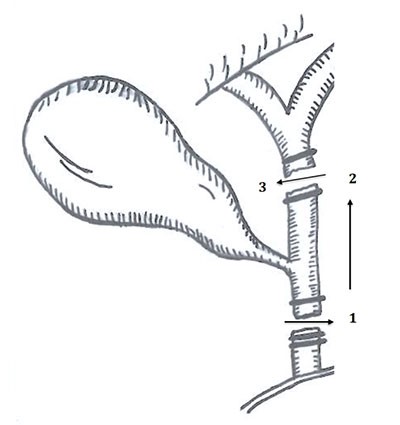A single incision was made overlying a line from the anterior superior iliac spine to the pubic tubercle, and was carried down through the fascia of Camper and the fascia of Scarpa. After dissection of the external abdominal oblique aponeurosis and cord structures, the hernia sac was identified and incised. However, it was determined to be empty, aside from a marginal amount of serous fluid. It was concluded that the appendix, previously confirmed on CT scan to be within the inguinal hernia, had spontaneously reduced. Tissue repair of the inguinal canal was completed without synthetic mesh using the Bassini approach, as perforation could not yet be ruled out.
Next, it was decided that laparoscopy would be required to enter the abdomen for localization and removal of the reduced appendix. Given the presence of a concurrent umbilical hernia, the decision was made to dissect the sac and place the Hasson trocar within the hernia to enter the peritoneal cavity. The appendix was determined to be inflamed, but not perforated. Following appendectomy and removal of trocars, the umbilical hernia sac was freed from its surrounding tissue and a primary repair was performed. Final pathology report revealed an appendix 1.2 cm in diameter with indurated meso-appendiceal fat, confirming acute appendicitis.
In the postoperative period, there were no complications to register. The patient was maintained on intravenous antibiotics for 24 hours and was discharged on the first postoperative day. Outpatient follow-up one week later revealed intact incision sites with no evidence of hematoma, seroma, or hernia recurrence.
Discussion
Localizing the appendix within an inguinal hernia was first detailed by Claudius Amyand in 1735.1 Clinical presentation generally varies based upon concurrent presence of acute appendicitis in the hernia. Even so, symptomology caused by an incarcerated hernia alone versus acute appendicitis may be difficult to distinguish. It is important to be cognizant of presenting variations of this condition, as the degree of hernia complication will direct surgical approach.
Losanoff and Basson established a four type classification for Amyand hernias along with recommended intervention, based on the status of the appendix. Type I is a normal appendix localized within the hernia sac, warranting primary reduction and mesh repair without appendectomy. Type II is acute appendicitis within the hernia sac prompting appendectomy through inguinal incision without mesh repair. Type III describes acute appendicitis with accompanying peritonitis; appendectomy is to be performed through laparotomy, followed by hernia repair without mesh. Type IV is acute appendicitis with or without abdominal disease, and therapy is left to the discretion of the clinician; if present, underlying abdominal pathology should be treated along with appendectomy.6-7
Existing literature presents incidental diagnoses of Amyand hernia intraoperatively, with normal appendices discovered through either open or laparoscopic approach. Because primary intent in these cases is hernia repair, the surgical plan remains unchanged and a tension-free mesh hernia repair is completed without appendectomy.2,5,8 A smaller subset of the literature details pre-operative diagnosis of incarcerated Amyand hernias by means of ultrasonography or CT scan prompting a single incision transherniotomy appendectomy.3-4
Our case classifies as a Type II Amyand hernia and the presence of complex fluid on imaging was concerning for a contaminated site. Ordinarily, these findings warranted a transherniotomy appendectomy as supported by existing literature,1,2,7 however, the spontaneously reducing appendix prompted swift surgical reevaluation. The unexpected finding thus required an unplanned two-step approach, consisting of primary hernia repair without mesh and subsequent laparoscopic appendectomy.
Conclusion
This paper details the case of a patient presenting with a right inguinal hernia containing acute appendicitis and possible perforation, as confirmed by CT scan. The Amyand hernia, a rare diagnosis, requires a well-planned surgical approach.1,7 Due to the unexpected reduction of the appendix into the abdomen, our planned transherniotomy appendectomy could not be performed. Instead, primary tissue repair and subsequent laparoscopic appendectomy was performed.
Lessons Learned
This is an unusual two-step surgical approach to an Amyand hernia not yet described in the literature. It is important for surgical teams to recognize this unexpected possibility in order to prepare a sound intraoperative plan.
Authors
Nikhil R. Shah, MD
University of Texas Medical Branch
Department of Surgery
Galveston, TX
Jeffrey Sohn, MD
Newark Beth Israel Medical Center
Department of Surgery
Newark, NJ
Alexis Okoh, MD
Newark Beth Israel Medical Center
Department of Surgery
Newark, NJ
Prakash Paragi, MD
Newark Beth Israel Medical Center
Department of Surgery
Newark, NJ
Correspondence
Nikhil Shah
University of Texas Medical Branch
Department of Surgery
301 University Blvd
Galveston, TX 77555
Phone: 409-772-0531
E-mail: nikshah@utmb.edu
Disclosures
The authors have no conflicts of interest to disclose.
References
- Amyand C. Of an inguinal rupture, with a pin in the appendix caeci incrusted with stone, and some observations on wounds in the guts. Phil Trans R Soc Lond. 1736;39:329–42.
- Morales-Cardenas A, Ploneda-Valencia CF, Sainz-Escárrega V, et al. Amyand hernia: Case report and review of the literature. Ann Med Surg (Lond). 2015 April 14;113–15.
- Smith-Singares E, Boachie JA, Iglesias IM. A rare case of appendicitis incarcerated in an inguinal hernia. J Surg Case Rep. 2016 June 6;2016(6).
- Velimezis G, Vassos N, Kapogiannatos G, Koronakis D, Perrakis E, Perrakis A. Incarcerated recurrent inguinal hernia containing an acute appendicitis (Amyand hernia): an extremely rare surgical situation. Arch Med Sci. 2017 April 1; 702–04.
- Maeda K, Kunieda K, Kawai M, et al. Giant left-sided inguinoscrotal hernia containing the cecum and appendix (giant left-sided Amyand’s hernia). Clin Case Rep. 2014 December 2. 254–57.
- Michalinos A, Moris D, Vernadakis S, et al. Amyand’s hernia: a review. Am J Surg. 2014 June; 207(6):989–95.
- Losanoff J, Basson, M. Amyand hernia: a classification to improve management. Hernia 2008;12:325–6.
- Sahu D, Swain S, Wani M, Reddy PK. Amyand’s hernia: Our experience in the laparoscopic era. J Minim Access Surg. 2015 April–June;11(2):151–3.


